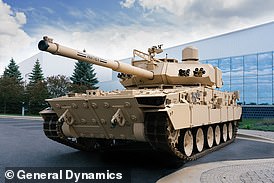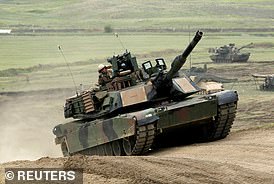Inside the US Army’s latest weapon of war: Officials release specs for new $13M combat vehicle the M10 Booker that they insist is NOT a tank
The U.S. military is upgrading its iconic Abrams tank for the first time in more than four decades and unveils the M10 Booker: a nimble killing machine for the modern battlefield.
The Pentagon prefers the term “combat vehicle” — but there can be no doubt that the $1.3 billion invested in the project so far is for the construction of the Army’s new flagship tank .
Designed in the 1970s, the Abrams, a colossal 67-ton beast, has been a fixture of the war on terror, deployed to Afghanistan, Iraq and Yemen.
But a new era of warfare requires a new type of tank.
Weighing just 42 tons, the Booker has the agility to support infantry where the Abrams couldn’t. Thanks to a boosted engine, she can drive for 24 hours and has a range of 560 kilometers – 160 kilometers more than the Abrams.

The M10 Booker will be an improvement over the classic M2A1 Abrams tanks (pictured), which were supplied to Ukraine during the ongoing Russian invasion
Since the Abrams replaced the Cold War era M60 Patton, transporting tanks around the world has been a persistent problem for the US military.
Upgrading to the Booker will seemingly cut this problem in half, as two of the tanks can be transported in a C-17 Globemaster carrier, compared to just one Abrams.
As the conflict in Ukraine becomes more urgent and President Biden pledges endless support to the nation, including 31 Abrams, the efficiency of US combat weapons seems to have become a priority.
The Booker is fitted with an array of advanced equipment, including a laser-targeted gun turret and thermal night vision goggles, and its lightweight design resembles something between a Soviet BMP infantry fighting vehicle and a smaller Abrams.
The Booker’s 360-degree 105mm turret is slightly shorter than its predecessor’s 120mm main gun, and the Abrams’ large design has earned it an unenviable reputation for being unwieldy and vulnerable in open spaces.
However, the Abrams is not retired from service by the Booker and remains the main battle tank for the US military. Including the M1 and M1A1 offshoots, well over 10,000 Abrams tanks have been produced (and many destroyed) over the years.
General Dynamics, the same company that produces Bookers for the US military, was also awarded a $4.6 billion contract to produce a new fleet of M1A2 Abrams tanks. The number of vehicles was not specified, but production is expected to continue until June 2028.
The Booker’s smaller size led to debate over its categorization, with some top executives wary of the word “tank” and preferring to downplay its potency.
Major General Glenn Dean, program director of Army Ground Combat Systems, told a news conference in June that the Booker will be used in a different capacity than its larger predecessors.
“The historical use of ‘light tanks’ is to perform reconnaissance functions, and this is not a reconnaissance vehicle, it is an assault rifle,” he said.
“Historically, it’s not actually a mission match, even though it looks, feels, and smells like (a tank).”
But the Booker’s status as the future of battle hasn’t always been smooth sailing, after early testing revealed that the main gun turret emitted toxic fumes that could have compromised soldiers’ safety.

The advanced combat vehicle is equipped with an array of high-tech equipment, including a laser aiming system from the turret and thermal night vision imaging
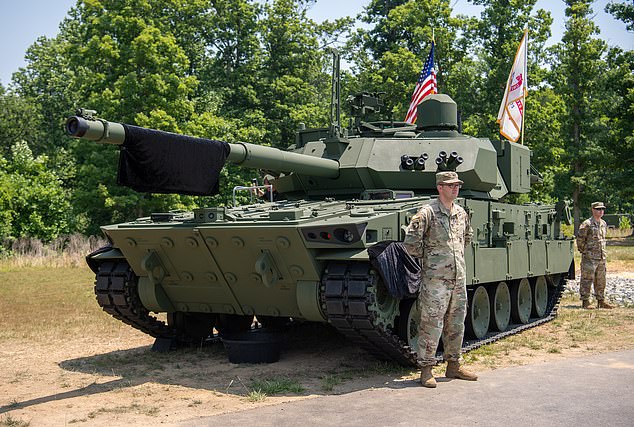
Officials plan to adapt the Booker’s lightweight design to the modern battlefield, including ease of transport and travel over unwieldy terrain
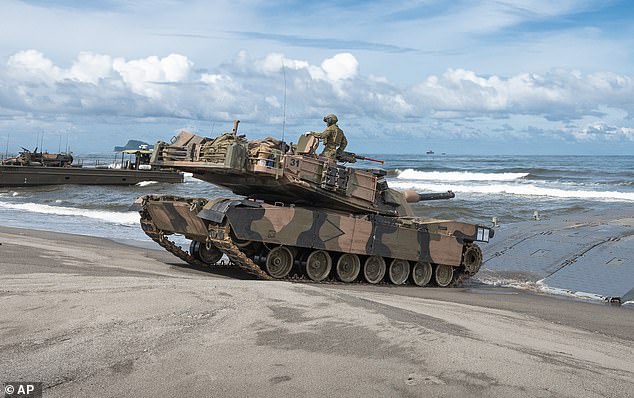
An Australian Army M1A1 Abrams Main Battle Tank of the 2nd Cavalry Regiment lands on the beach during a large-scale combined amphibious assault exercise Friday, August 25, 2023 at a naval base in San Antonio, Zambales, Philippines
Dean acknowledged the problem when he revealed Booker’s name in June, saying test drives raised concerns when “high levels of toxic fumes” filled the vehicle when the gun was fired.
Dean added that the issue was resolved quickly and said: “I’m pleased to report that toxic fumes were one of our concerns in the manufacturing decision and we did some engineering and testing, and I can confidently say today that that such is an issue that is behind us.’
Production on the Booker ramped up last summer, when General Dynamics Land Systems won a hefty contract worth more than a billion dollars to build 96 of the vehicles.
The “light tanks” will be manufactured in Michigan, Alabama and Ohio, and Dean said he expects the first shipments of the vehicles to arrive in November, reportedly ahead of schedule. The first battalion on the front line could be reinforced by Bookers in late 2024.
The first glimpses of the Booker sparked a wave of excitement among military fans and gearheads alike, as the long-standing clamor for the U.S. military to improve its ground fleet and redevelop a high-performance ground vehicle was finally answered.
Many trace the idea of funding a state-of-the-art “tank” to around 2014, when Russia prevented its invasion of Ukraine by annexing the Crimea region.
President Biden called the classic Abrams tanks “the most capable in the world” when he controversially pledged the vehicles to Ukraine in January, seen by many as a direct escalation of America’s role in fighting the Russian invasion.
However, the presence of the Abrams in Ukraine was a major turning point, leading some Russian forces to create inflatable versions of the tanks to deceive their opponents on the battlefield.
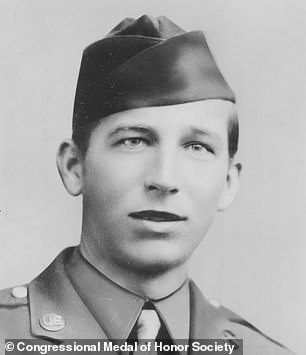
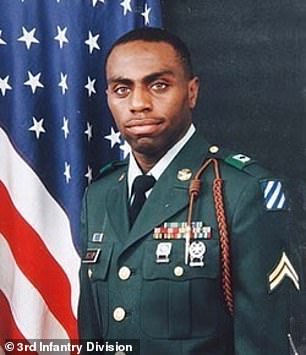
In June, the vehicle was renamed after two veterans who died in combat nearly 60 years apart: World War II Infantryman Private Robert Booker (left), who was killed in action on April 9, 1943, and Staff Sergeant Stevon Booker (right), a tanker who assassinated in Baghdad on April 5, 2003
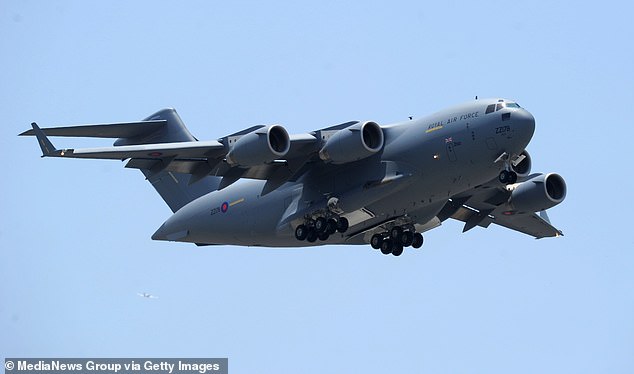
A major improvement to the Booker is its lightweight design, and two of the vehicles fit on a C-17 Globemaster III aircraft carrier, compared to just one Abrams aircraft carrier.
In 1991, the Abrams tanks were first used on the front lines, more than a decade after they were introduced to the military. They were an instant success during Operation Desert Storm in the Gulf Wa5r, where they destroyed over 2,000 Iraqi tanks, compared to just nine M1 tanks.
In 1999, the production of an Abrams tank reportedly cost about $5 million. Today, the Booker is expected to cost around $13 million.
The Abrams tanks also underwent numerous modifications over the years, including upgrading some versions with uranium armor and protection against biological or chemical attack.
Upgrading the Abrams was no easy feat, and the new suite of combat features on the Booker led Scott Boston, a defense analyst at the Rand Corporation, to note that the vehicle could revolutionize the way the U.S. military behaves in combat. future battles through rugged terrain.
“The M10’s battlefield role will be to support the deployed infantry troops,” he said Wall Street Journal. “The Booker basically gives you armor support you wouldn’t otherwise have.”
“It can carry a wider variety of ammunition, and it can go places an armored Humvee can’t go,” he added, noting that the Booker may be able to travel over certain bridges due to its lower weight.
The new fleet of “light tanks” was initially branded “Mobile Protection Firepower” (MPF), before officials decided to name the weapon after two fallen soldiers who died nearly 60 years apart.
The M10 Booker is named after World War II infantryman Robert Booker, who died April 9, 1943, and Staff Sergeant Stevon Booker, a tanker who died in Baghdad on April 5, 2003.
“The stories of these two heroic soldiers accurately articulate the military’s needs for the M10 Booker combat vehicle,” said Doug Bush, chief of army acquisition, when the tank was renamed in June.
“Our soldiers will now have an infantry assault vehicle that will bring a new level of lethality to our ground forces and enable our uniformed men and women to move faster with greater protection.”

